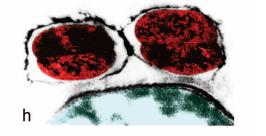Vampirococcus
Classification
Higher order taxa
Kingdom: Prokaryotae
- Domain: Bacteria
- Phylum: Unknown
- Class: Unknown
- Order: Unknown
- Family: Unknown
- Order: Unknown
- Class: Unknown
- Phylum: Unknown
As of 2008, "Phylogenetic Analysis of Vampirococcus and Daptobacter has yet to be undertaken...[1]"
Species
- Genus: Vampirococcus
- Species: Unknown
Description and significance
Vampriococcus is one of few known predatory prokaryotes. It is a 0.6 micrometer, ovidal bacteria of which no modal forms have been found. It is a gram-negative bacteria that is found in freshwater sulfurous lakes in northern Spain.As an anaerobic epibiont, it attaches itself to the surface of phototropic bacteria, by specific structures, and as it grows and devides by fission, it destroys its prey [2].
Sources
[1] Whitworth, David E. "Myxobacteria [electronic resource] : multicellularity and differentiation" Washington, DC : ASM Press, c2008.
[2] Ricardo Guerrero,Carlos Pedros-Alio Et al. Predatory prokaryotes: Predation and primary consumption evolved in bacteria, Evolution and Microbiology, Vol. 83, pp. 2138-2142, April 1986

